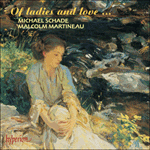Sylvie succeeds where
Hymne does not, simply because Paul de Choudens, an unpublished amateur poet, was no Baudelaire. (He was also a recently appointed partner in his father’s music publishing business.) The text makes no demands beyond the conventions of a young man using flowery language in which to salute his paramour of the moment. It is a beautifully crafted song with deft piano writing that lies ‘just so’ under the hands. Any pianist, having mastered the fingering, will acknowledge the pleasure of playing the gently rising figurations first encountered in bars 3 to 4; to reach the tonic chord with some delicacy after traversing a small thicket of sharps and flats in contrary motion is like executing a complicated embroidery stitch, or potting the black in a game of snooker. This is music for the salon, and it has the salon’s light touch; the incessant semiquavers of the accompaniment suggest the fluttering of butterflies’ wings. Fauré referred to the song as a ‘labour of Hercules’ because it was written to spur Choudens
père et fils into the swift publication of Fauré’s first
recueil of mélodies (this suggests the politically astute Saint-Saëns plotting in the background on behalf of his protégé). The strain does not show. A fine singer can make much of the gentle undulations of the vocal line, and the ease with which the music unfolds belies the composer’s skill in tonal manipulation. The piece is an example of Fauré’s mastery in writing an eloquent, yet economical, bass (as in bars 34 to 39) that steers the progress of the music like a rudder. The style of Massenet (no friend of Fauré) comes to mind, not least because there is a belle époque languor in this music which co-exists with its ardour. Too often one hears this song as an unmoderated Allegro; it should encompass both the industry and the laziness of a gently buzzing bee. ‘Tes yeux brillants et langoureux’, says the poet.
from notes by Graham Johnson © 2005
Si
Sylvie réussit là où
Hymne échoua, ce fut tout simplement parce que Paul de Choudens, poète amateur inédit, n’était pas Baudelaire (il venait d’être nommé associé dans la maison d’éditions musicales paternelle). Le texte s’en tient aux convenances d’un jeune homme saluant son amour du moment dans un langage fleuri. C’est une mélodie magnifiquement ciselée, avec une écriture pianistique habile, qui vient «juste comme il faut» sous les mains. Tout pianiste maîtrisant les doigtés sera reconnaissant du plaisir éprouvé à jouer les figurations doucement ascendantes rencontrées pour la première fois aux mesures 3–4; atteindre l’accord de tonique avec délicatesse, après avoir traversé un petit hallier de dièses et de bémols en mouvement contraire, c’est comme exécuter un point de broderie compliqué, ou blouser la bille noire au snooker. C’est une musique destinée au salon, et elle a la légèreté du salon; les incessantes doubles croches de l’accompagnement évoquent les battements d’ailes des papillons. Un «travail d’Hercule»: voilà comment Fauré parlait de cette mélodie écrite pour inciter les Choudens père et fils à vite publier son premier recueil de mélodies (ici plane l’ombre de Saint-Saëns qui, en fin stratège, complotait par derrière pour son protégé). Mais l’effort ne se sent pas. Une belle voix peut faire beaucoup des douces ondulations de la ligne vocale, et l’aisance avec laquelle la musique se déploie trahit une impressionnante maîtrise de la manipulation tonale. Cette pièce illustre avec quel brio Fauré pouvait écrire une basse éloquente, quoique parcimonieuse (comme aux mesures 34–39), véritable gouvernail commandant le déroulé de la musique. On pense au style de Massenet (qui n’était pas ami de Fauré), surtout parce que l’ardeur de cette musique voisine avec une langueur «Belle Époque». On entend trop souvent cette mélodie comme un Allegro non modéré; elle doit renfermer et l’ardeur au travail et l’indolence de l’abeille bourdonnant gentiment. «Tes yeux brillants et langoureux», dit le poète.
extrait des notes rédigées par Graham Johnson © 2005
Français: Hypérion


 Fauré: The Complete Songs, Vol. 1
Fauré: The Complete Songs, Vol. 1 Of ladies and love
Of ladies and love
